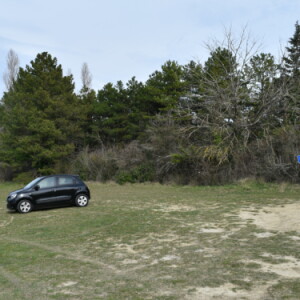Out and about in the ‘hood: Part 2
Flushed with the success of yesterday’s outing – especially the Suze-la-Rousse bit – we decided to head out to other places nearby that might have other hitherto unguessed stories to tell.
Started off with a visit to the neighbouring village of La Bâtie-Rolland, which was built up around a big hill in the middle of the plane. S. suggested we walk up it – some hikers’ guide or other had suggested that it was an easy climb – and I was keen to see how the hips would respond after yesterday’s exertions, so off we went. My first thought was that all French hikers are liars. The climb was essentially vertical in parts and the hill must have its own microclimate because the path was wet and slippy. Still, we made it to the top, and after I had spent 30 minutes lying on a bench recovering, I was in a better position to appreciate the view. There was a ruined chapel on the hill – I suppose it might have been some sort of fortified area at times – and it lent a sense of grandeur to the place, which otherwise seemed completely ignored. We climbed down via the old village, which had a wonderful stone theatre built into the hillside, and then decided to head on somewhere else. Puygirol was the lucky recipient this time around.
I’d never heard of Puygirol before, which I suppose is not too surprising given its size, but I was quite impressed. Perhaps its best view is from a distance – a photo I failed comprehensively to take – as it is very compact, and the towers of the chateau and the church rise out of a higgledy-piggledy maze of small streets, meaning any photo is out of context and unable to capture a sense of scale. I say “any photo”, but what I mean of course is “any photo I take”.
Before long (it is a very small place), we had found the rue des Pierres Taillées, which boasted a little placard explaining how the wealth of the village had come from its stone, which had been used to build such luminary buildings as the Opéra Garnier in Paris, the columns and the floor at the Fourvière Basilica in Lyon, and the Pyramids in Egypt. (I might have made that last one up – just wanted to check you were still awake.) It certainly explained the wealth of the place. What it couldn’t explain though was the absence of people. Yes, it was Sunday, but the place was dead. It was like the village of the damned. Everywhere there were signs of life (as with Valréas yesterday): schoolyards gaily decorated; laundry hanging from windows, flapping in the breeze; a cat mewling at the door: what there wasn’t was a single solitary human being. Or noise. It was silent, as if a great plague had suddenly swept down and wiped out humanity. Then, as we were leaving, a door opened, and the face of an old man looked out: he stared at me for a second and then, very slowly, very deliberately, very quietly, closed the door once again. There is only so much excitement you can take at that age.
Feeling somewhat disquieted by the whole affair, and encouraged by a phone call from S’s cousin Mireille, who wanted to know where we had managed to get to, we decided to carry on to La Laupie. “It’s worth the visit,” she had said. S had never been before, and nor had I, obviously, so off we went.
La Laupie is a medieval village built on the site of an old gallo-roman settlement. It gradually fell into disrepair until a group of people all got together in 1965 and decided to renovate it. Since then, its residents had rebuilt it and it is now a private community, into which cars are not allowed. Or at least outside cars (by that I mean cars driven by non-residents and not cars that are used outside, because that would be silly). We found the car park, which was a massive piece of land on which not a single car was parked. I soon changed that (see extra). We wandered up to the village, which was quite beautiful and immaculately renovated. However, it made Puygirol seem like party central: there was the same sense of a sudden catastrophe having hit the place. As we wandered down the streets, I saw a door was open—wide open, mind—but there was no sign of life. I briefly contemplated calling a concerned “bonjour”, but decided against it in case some gallic serial killer had been busy and was still inside. Up and down the streets we went, eventually finding our way to the cemetery with its glorious war memorial (Honneur aux enfants de la patrie, morts pour la France). As beautiful as it was, it was obviously a village full of résidences secondaires and, sadly, completely soulless. As we left, I couldn’t help but feel that it was the least favourite place I had visited on this trip. And perhaps one of the most attractive. Very much the Gwyneth Paltrow of Drôme villages.
Home to dinner and spent the evening watching Jean de Florette, which I hadn’t seen and struggled to understand without the subtitles (accents strong enough to cut you), but which I really, really liked. I’ll have to go back and read the novels…


Comments
Sign in or get an account to comment.


